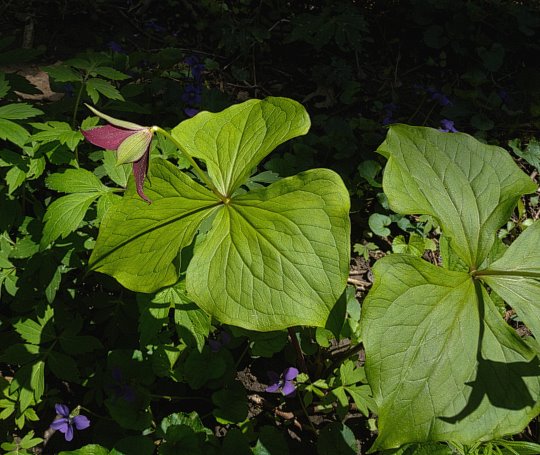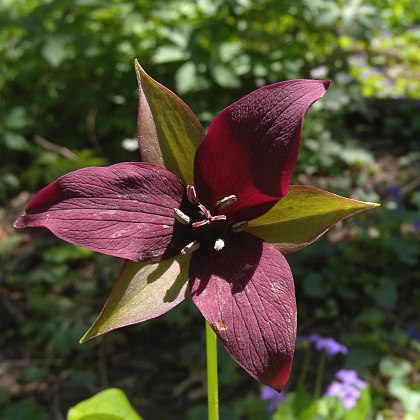
When the flower is open, both petals and sepals are widely spreading; they are about the same length and similar shape, although the sepals are more narrow. The petals and sepals are lanceolate to ovate in shape and glabrous. The relatively small stamens have anthers and filaments that are about the same length; the anthers have light gray to yellowish pollen. The blooming period occurs from mid- to late spring for about 2-3 weeks. The flowers often have an unpleasant scent. Afterwards, the ovary matures into a dark maroon fruit that is broadly ovoid, 6-angled, and about ½" long. This fruit contains several seeds. The root system is fibrous and rhizomatous. Clonal colonies of plants are often produced from the rhizomes.
Cultivation: The preference is dappled sunlight or light shade during the spring, followed by shade during the summer. The soil should be more or less moist and contain loam with decaying organic matter. Some protection from prevailing winds is also desirable. It takes a long time for this trillium to mature from seed (typically 5-10 years). The foliage dies down later in the summer.

Range & Habitat: The native Red Trillium is a rare wildflower in Illinois, where it is state-listed as 'endangered.' It is restricted to a few counties in the northern section of the state (see Distribution Map). Habitats consist of rich deciduous woodlands that are more or less mesic and wooded slopes. In such woodlands, Sugar Maple (Acer saccharum), American Basswood (Tilia americana), or oaks (Quercus spp.) are often dominant canopy trees. Further to the east, where it is more common, Red Trillium is associated with woodlands that are dominated by Sugar Maple and American Beech (Fagus grandifolia). This wildflower is sometimes cultivated in shaded gardens.
Faunal Associations: Because the petals of the flowers have the color of rotting flesh and often exude a similar odor, they probably attract flesh flies, carrion beetles, and similar insects. The polyphagous larvae of two moth species, Clepsis melaleucana (Black-Patched Clepsis) and Euplexia benesimilis (American Angle Shades), have been observed to feed on the leaves of Trillium spp. The foliage is also vulnerable to browsing by White-tailed Deer: This has caused the decline of trillium populations in some parts of Illinois. Food-appendages of the seeds are designed to attract ants and possibly other insects. As a result, the seeds of Trillium spp. can be carried several feet from the mother plant by these insects, thereby helping to spread these flowering plants into neighboring areas.

Photographic Location: A flower garden in Urbana, Illinois.
Comments: This wildflower lacks a dominant common name: It has been referred to as Red Trillium, Purple Trillium, Ill-Scented Trillium, Stinking Benjamin, Stinking Willie, and Birthwort. In addition to maroon (reddish purple), the flowers of this species can be white, pink, yellow, or green. Some of these variations may be the result of hybridization with other Trillium spp. In Illinois, only plants with maroon-colored flowers have been encountered in the wild. Red Trillium is fairly easy to identify because it is the only maroon-flowered trillium within the state that holds its flower above the leaves on a more or less erect peduncle (flowering stalk). Two other species in Illinois, Trillium recurvatum (Prairie Trillium) and Trillium sessile (Sessile Trillium), also have maroon-colored flowers, but they are sessile. The white-flowered form of Red Trillium can be distinguished from other white-flowered Trillium spp. by its dark maroon ovary.